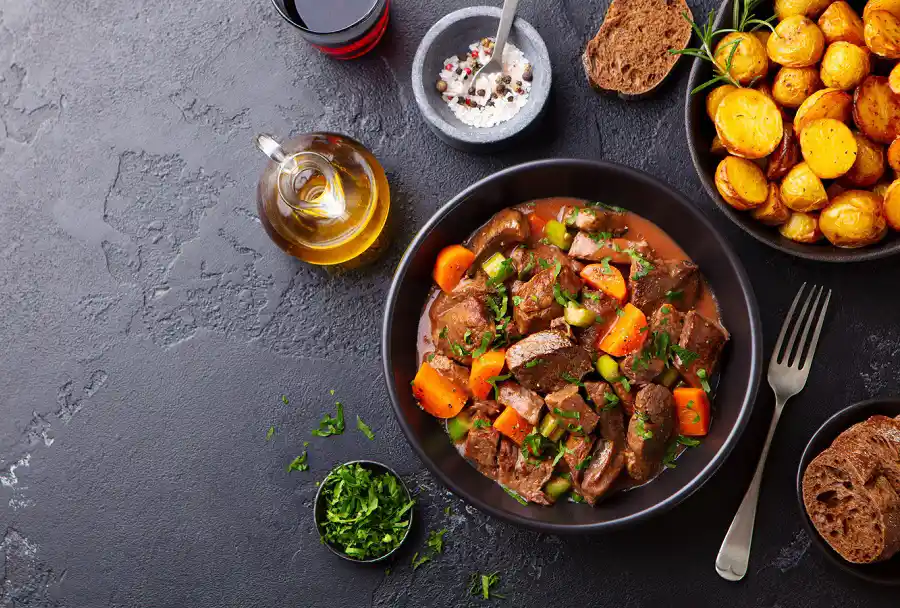Stews are hearty, satisfying dishes that warm the soul and fill the belly. Whether you’re a cooking novice or an experienced home chef, stew recipes are both accessible and rewarding. In this article, we’ll explore the world of stew recipes, providing easy-to-follow steps and tips for creating mouthwatering stews that will become your go-to comfort meals.
1. What Makes a Great Stew?
a. Key Ingredients
Stews are typically composed of tender meat or hearty vegetables simmered in a flavourful broth. The magic often lies in the slow-cooking process that melds these elements into a harmonious and comforting dish.
b. Versatility
Stew recipes are incredibly versatile, allowing you to use your favorite proteins and seasonal vegetables. You can also customize the flavors with spices, herbs, and seasonings to suit your taste.
2. Choosing Your Ingredients
a. Meat Options
Common meat choices for stews include beef, chicken, lamb, and pork. Opt for cuts that benefit from long, slow cooking, like chuck roast, bone-in chicken thighs, or lamb shanks.
b. Vegetables Galore
Stews are an excellent way to incorporate a variety of vegetables into your diet. Carrots, potatoes, onions, celery, and bell peppers are classic choices, but you can get creative with ingredients like mushrooms, peas, or butternut squash.
3. Essential Equipment
a. The Right Pot
A heavy-bottomed, large pot or Dutch oven is essential for stew making. Its even heat distribution and depth allow for proper simmering and flavor development.
b. Long and Low
Stews benefit from long, slow cooking over low heat. A slow cooker or crockpot is another convenient option if you prefer a hands-off approach.
4. Steps to Stew Success
a. Sear the Meat
Start by searing the meat in a bit of oil until it develops a brown crust. This adds depth of flavor to your stew.
b. Onions and Aromatics
Sauté onions and garlic until they’re soft and fragrant. Add any other aromatics you like, such as ginger, thyme, or bay leaves.
c. Liquid Love
Pour in your choice of liquid, which can be broth, wine, beer, or even tomato sauce. The liquid helps tenderise the meat and infuse the stew with flavour.
d. Simmer Slowly
Lower the heat and let your stew simmer gently. The low and slow cooking process allows the flavours to meld and the meat to become fork-tender.
e. Vegetables in Stages
Add vegetables in stages, so they don’t overcook. Start with those that take longer to soften, like carrots and potatoes, and add quicker-cooking veggies later.
5. Recipe Ideas
a. Classic Beef Stew
Ingredients:
- 1.5 lbs (700g) beef chuck, cut into chunks
- 1 onion, chopped
- 2 cloves garlic, minced
- 3 carrots, sliced
- 3 potatoes, diced
- 1 cup beef broth
- 1 cup red wine (optional)
- 2 bay leaves
- Salt and pepper to taste
Instructions:
- Sear the beef in a pot until browned, then set it aside.
- Sauté the onions and garlic until soft.
- Add carrots and potatoes, then return the beef to the pot.
- Pour in the beef broth and wine, if using.
- Add bay leaves, salt, and pepper.
- Simmer on low for 2-3 hours until the meat is tender.
b. Chicken and Vegetable Stew
Ingredients:
- 4 bone-in chicken thighs
- 1 onion, diced
- 2 cloves garlic, minced
- 3 carrots, chopped
- 2 potatoes, cubed
- 4 cups chicken broth
- 1 teaspoon thyme
- Salt and pepper to taste
Instructions:
- Brown the chicken thighs in a pot, then set them aside.
- Sauté onions and garlic until fragrant.
- Add carrots and potatoes to the pot.
- Return the chicken to the pot, pour in the chicken broth, and add thyme, salt, and pepper.
- Simmer on low for 45-60 minutes until the chicken is cooked through.
6. Serving Suggestions
a. Bread Companions
Stews pair wonderfully with crusty bread, which can be used for dipping and sopping up the flavorful broth.
b. Garnish Galore
Enhance the visual appeal and taste of your stew with fresh herbs like parsley or a dollop of sour cream or yogurt.
7. Storing and Reheating
a. Refrigeration and Freezing
Stews can be refrigerated for several days or frozen for longer-term storage. Allow them to cool before storing in airtight containers.
b. Reheat Slowly
When reheating, do so slowly over low heat to prevent the meat from becoming tough and the vegetables from overcooking.
8. Stew for the Soul
Stew recipes are a comforting and customizable option for home cooks of all skill levels. With the right ingredients, equipment, and cooking techniques, you can create hearty, flavourful meals that are perfect for any season. So, grab your favourite ingredients, your trusty pot, and embark on a stew-making adventure that will warm your heart and satisfy your taste buds.

